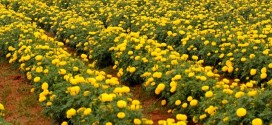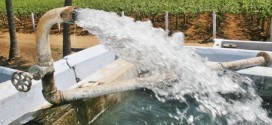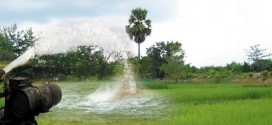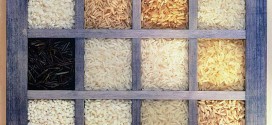Floriculture, or flower farming, is a discipline of horticulture concerned with the cultivation of flowering and ornamental plants for gardens and forfloristry, comprising the floral industry. The development, via plant breeding, of new varieties is a major occupation of floriculturists. Floriculture crops include bedding plants, houseplants, flowering garden and pot plants, cut cultivated greens, and cut flowers. As distinguished from nursery crops, floriculture crops are generally herbaceous. Bedding and garden plants consist of young flowering plants (annuals and perennials) and vegetable plants. They are grown in cell packs (in flats or trays), in pots, or in hanging baskets, usually inside a controlled environment, and sold largely for gardens and landscaping. Pelargonium (“geraniums”), Impatiens (“busy lizzies”), and Petunia are the best-selling bedding plants. The many cultivars of Chrysanthemum are the major perennial garden plant in the United States. Flowering plants are largely sold in pots for indoor use. The major flowering plants are poinsettias, orchids, florist chrysanthemums, and finished florist azaleas. Foliage plants are also sold in pots and hanging baskets for indoor and patio use, including larger specimens for office, hotel, and restaurant interiors. Cut flowers are usually sold in bunches or as bouquets with cut foliage. The production of cut flowers is specifically known as the cut flower industry. Farming flowers and foliage employs special aspects of floriculture, such as spacing, training and pruning plants for optimal flower harvest; and post-harvest treatment such as chemical treatments, storage, preservation and packaging. In Australia and the United States some species are harvested from the wild for the cut flower market.
Read More »Monthly Archives: April 2013
Water Requirement for Crops
CRITICAL GROWTH STAGES AND WATER REQUIREMENTS OF IMPORTANT CROPS Crop Critical growth stages Average crop duration (days) Water requirement (mm) Rice Tiller initiation, flowering and milky stage 90-130 900-2500 Crop Critical growth stages Average crop duration (days) Water requirement (mm) Wheat Crown root initiation, flowering, joining, milky and tillering 135 400-450 Crop Critical growth stages Average crop duration (days) Water requirement (mm) Pulses Flower initiation and pod filling 90-120 250-300 Crop Critical growth stages Average crop duration (days) Water requirement (mm) Groundnut Pegging and pod formation 105 600-450 Crop Critical growth stages Average crop duration (days) Water requirement (mm) Sugarcane Emergence, tiller formation and elongation 330 1400-3000 Crop Critical growth stages Average crop duration (days) Water requirement (mm) Banana Early vegetative phase, bunch initiation and flowering 300 3000 Crop Critical growth stages Average crop duration (days) Water requirement (mm) Cassava Rooting, early tuberization and tuber development 300 400-750 Crop Critical growth stages Average crop duration (days) Water requirement (mm) Maize Silking and cob development 100 400-600 Crop Critical growth stages Average crop duration (days) Water requirement (mm) Sorghum Knee-height stage, flowering and grain filling 100-120 250-300 Crop Critical growth stagesAverage crop duration (days) Water requirement (mm) Cotton Commencement of sympodial branching, flowering, boil formation and boil bursting 165 600-700
Read More »Pumpset Selection
1 H.P Pumpset gives a discharge of 2200 gallons/hr. normally. Viz. 22,000 gallons in 10 hrs (1 inch of water in one acre – 1 acre inch). Discharge according to size of pumpset 1 H.P., 1″ x 1″, 1 1/2″ x 1 1/2″ pumpsets – 2,000 – 3,000 gph. 1 1/2 H.P., 1 1/2″ x 1″, 2″ x 1 1/2″ pumpsets – 3,000 – 4,000 gph. 2 H.P., 2″ x 2″, 2 1/2″ 2″, 3″ x 2 1/2″ pumpsets – 5,000 – 6,000 gph. 3 H.P., 2 1/2″ x 2″, 3″ x 2 1/2″ 2″ x 2″ pumpsets – 6,000 – 7,000 gph. 5 H.P., 4″ x 3″, 3″ x 2 1/2″, 2 1/2″ x 2″ pumpsets – 10,000 – 12,000 gph. Working out area and depth of irrigation. Example: 5 H.P. Pumpset. If this pump is worked for 10 hrs, it gives a discharge of 1,10,000 gallons of water approximately. If the area of the farm is five acres, the depth of water will be 1,10,000/22,000 which is five inches (22,000 gallon = 1 inch in one Acre). Precautions to be taken while errecting a pump Maximum suction head shall not exceed 7 mts. (20 ft). Suction head is measured from water surface of source to pump level vertically. Suction pipe shall be erected vertically. It shall never be allowed in a slanting position. There shall not be any leak on the suction side. Foot valve must rest at least 1 mt. above the water bed. If foot valve touches ground, it will such dirt and sand, and pumping system will fail. Polythene pipes are preferable to avoid frictional loss. Usually centrifugal pumps are used where suction is less than 7 mts. A single stage pump is used where total head (suction head + delivery head) isj not more …
Read More »New Varieties
New Varieties of Crops suited for Kerala RICE Varsha Duration 115-120 days (Kharif). 105-110 days (Rabi and Summer) Yield Grain – 3787 kg/ha Straw – 6835 kg/ha Characters Photoperiod insensitive, non-lodging, mid early variety resistant to WBPH and moderately resistant to blue beetles. Low susceptibility to blast and sheath blight under field conditions. Kernel red. long bolo and non-glutinous. Recommended for double crop wet lands of Palakkad and Thrissur. Dhanu Duration 159 days. Yield Grain – 3750 kg/ha Straw – 7188 Kg/ha Characters Photosensitive, Semitall, late maturing variety suitable for second crop season in Onattukara region. Withstand flood and drought conditions. Tolerant to stemborer, moderately tolerant to sheath blight, brown leaf spot, Red Kernel, Resistant to shattering. Chingam Duration 98 days. Yield Grain 3910 kg/ha Characters Non-photosensitive, Semitall, non lodging, early variety suitable for dry sowing in Onattukara region for Virippu season. Moderately tolerant to shealth blight and brown leaf spot. Tolerant to stemborer. Kernel red. Kunjukunju Varna Duration 110-115 days. Yield High Yield Potential Characters Photoperiod insensitive, early maturing, red rice variety. moderately tolerant to major pests like gall fly,leaf folder, whorlmaggot and stemborer. Moderately resistant to blast and moderately susceptible to shealth blight. Non-lodging, non-shattering and responsive to fertilizer. Suitable for double cropped areas of Palakkad, Thrissur and Ernakulam. Kunjukunju Priya Duration 105-110 days Yield High Yield Potential Characters Early maturing red rice. Non-lodging, non-shattering and fertilizer responsive. Moderately resistant to blast. Moderately susceptible to shealth blight. Moderately tolerant to major pests like gall fly, leaf folder, whorl maggot and stem borer. Suitable for double cropped areas of Palakkad, Thrissur and Ernakulam. Gouri Duration 115-120 days. Yield High Yield Potential Characters Medium tillering, dwarf, non-lodging medium duration variety moderately resistant to major diseases and pests. Kernel medium bold and red. Recommended for Kuttanad and Kole regions of Kerala. …
Read More »Fertilizer
FERTILIZER RECOMMENDATION FOR MAJOR CROPS N P K PADDY (kg/ha) Upland(Modan) PTB 28,29 and 30 High-yielding short duration varieties 40 60 20 30 30 30 Wet land (All regions) High-yielding short duration varieties High-yielding medium duration varieties Local varieties H4 Mashuri 70 90 40 70 50 35 45 20 45 25 35 45 20 45 25 COCONUT (Adult palm)kg/palm/annum. General recommendation (a) Average management (b) Good Management (c) For reclaimed clayey soils (as in Kuttanad) 0.34 0.50 0.25 0.17 0.32 0.35 0.68 1.20 0.90 Hybrid and high yielding palm (a) For irrigated areas (b) Rainfed 1.00 0.50 0.50 0.32 2.00 1.20 RUBBER From 1st year to 4th year :-10:10:4:1.5 NPK Mg mixture at the following rates: 3rd Month 225g / plant 9th Month 450g / plant 15th Month 450g / plant 21st Month 550g / plant 27th Month 550g / plant 33rd Month 450g / plant 39th Month 450g / plant From 5th year till tapping begins 12:12:12 NPK Mixture @ 125 kg /ha during April – May and September – October (Where mulching was practiced during initial years) 15:10:6 NPK Mixture @ 200 kg /ha during April – May and September – October (Where mulching was not practiced during initial years) Mature Rubber under tapping 10:10:10 NPK Mixture @ 300 kg /ha or 900 g / plant March -April or 15:15:15 NPK Mixture @ 200 kg /ha or 17:17:17 NPK Mixture @ 175 kg /ha or 19:19:19 NPK Mixture @ 160 kg /ha N P K TAPIOCA (kg per hectare) H.97, H.226 75 75 75 H.165, H.1687, H.2304 100 100 100 M4 and Local 50 50 50 SWEET POTATO (kg/ha ) 75 50 75 SESAMUM (kg/ha ) 30 15 30 GROUNDNUT (kg/ha ) 10 75 75 BANANA (g/plant) Nendran (irrigated ) 190 115 …
Read More »Kerala at a Glance
Area- 38,863 Sq.Km Percentage of Area to the area of Indian Union- 1.18 Length of Costal Line- 580 KM Highest Peak- Anamudi (2694 meters) West flowing rivers- 41 Nos. East flowing rivers- 3 Nos. Districts- 14 Nos. Taluks- 75 Nos. Revenue Villages- 1535 Nos. Grama Panchayats- 941 Nos. Corporations- 6 Nos. Municipalities- 86 Nos. M.L.A.s Elected- 140+ 1 Anglo Indian Nominee. Rajya Sabha- 9 Nos. Community Development Blocks- 152 Nos. Average Annual Rainfall- 2900 mm. Percapita land- 0.12 ha. Percapita production of food grain- 21.6 kg. No. of Padasekharams- 7359 No. of Kurumulaku Samrakshana Samithies- 1409 No. of Haritha Sanghams- 1581
Read More »Irrigation and Cropping Pattern
Around 22% of the total cropped area which comes to around 0.65 m ha. is the irrigated area in Kerala. About 90% of total irrigation water is used for food crops of which 80% on rice and 10% on other food crops: A number of irrigation projects have been taken up in Kerala. When all the ongoing and envisaged projects are completed, it is expected to benefit about 0.2 m hectares. Since population is high, area of cultivation is proportionately high compared to geographical area of the state. Now-a-days, the state has developed commercial agriculture more than food crops. According to 1992-93 survey, out of 30.211akh hectares, the share of food crops (cereals, millets, pulses and tapioca) was only 23 percent. A wide variety of crops preferring cool; humid climate are cultivated. Kerala has unique cropping pattern. It accounts for 92% of India’s rubber production, 70% of coconut, 60%’of tapioca and almost 100% of lemon grass oil. Rubber, coconut and tapioca are grown in low elevation under humid-tropical conditions. Crops like tea, coffee, cardomom are cultivated in highlands. The crops like banana, pepper, ginger, tapioca, rubber are grown in midlands. Kerala is the single largest producer of banana also. It holds monopoly with regard to rubber and pepper. Besides the commercial crops like rubber, tea, coffee, pepper, cashew, rice is the important crop of the state as a staple food of the people. It occupies nearly 30% of the total cropped area followed by coconut 25% and tapioca 10 percent. Rubber occupies an area of 4,37,100 hectares, tea around 34, 700 hectares coffee and cardamom 39,930 hectares as per 1992-93 survey. Refer table 2 for more details. Table 1 : Important crops grown in Kerala Sl.No Name of crop Area (thousand hectares) 1 Rice 807 2 Coconut 667 3 Areca …
Read More »Problem Soils of Kerala
Problem Soils and Management Acidity, salinity, water logging and poor physical properties are the major problems that exist in the state. 1. Kuttanad arid soils Very strong soils (with pH less than 3.0) that are seen in Kuttanad areas are kept submerged in water for major part of the year as they lie below sea level: So, this area faces problems of floods and water stagnation. Toxicities of iron, aluminium, manganese are observed and the availability of calcium, magnesium, potassium is low. The organic matter rich soils of Kuttanad faces drainage problem apart form acidity. Occurrence of heavy rainfall damages the bunds while flooding results in severe crop damage. Management Research on soil acidity and plant growth, water management studied has to be intensified and proper agro-techniques for this area have to be framed. Apart from this, as rice is the major crop that is taken up for cultivation, certain precautions certainly helps to increase the productivity. Rice season starts by September-October and ends by January-February. Seeds should be sown only after dewatering the area. The soil should not be allowed to dry up after the seeds are sown. Formation of deep cracks and hand pans can be eliminated by submerging the field. 2. Kole soils Kole soils are also water-logged in nature like Kuttanad soils covering 11,000 ha in Trichur and Malappuram. The soils are shallow, acid saline due to intrusion of water, the characteristic feature that makes these soils to differ from Kuttanad acid soils. The soil is hard and brittle, poor in fertility. Management Intrusion of seawater is to be prevented and heavy doses of manures and fertilizers are to be applied. By proper soil and water management suitable cropping system is to be adopted. 3. Coastal sandy soils . Poor fertility, high water table, improper drainage …
Read More »Topography
Based on the physical features Kerala is classified as given below High Ranges (above 750m MSL) The mountainous land (elevation: 750 m to 2500 m above MSL) along the Western Ghats with jutting rocks and loamy soils constitutes the High Ranges. The two districts of Wayanad and Idukki and the eastern parts of the other districts bordering the Western Ghats come under this class. Most of the reserve forests of the state are in this tract. The important peaks in the Western Ghats are Anamudi (2690 m), Mukunti (2550m) and Nilgiris (2470m). The Palakkad gap with a width of 32 km is the largest pass in the Western Ghats. In addition, there are a few other passes in the Ghats such as Aramboli, kumali, kambam, Thevaram,Bodinaikannuur, karkken, periya and Perambadi. Plantations of tea, coffee, rubber and cardamom dominate the High Range region. High land (75-750m above MSL) This hilly tract on the western side of Western Ghats, comprising about 43 per cent of the land and supporting 14 per cent of the population, is covered with forests and small streams. Plantations of tea, coffee, cardamom and rubber are common. The soils are generally forest loams, which show wide variation in depth with a very high percentage of organic matter. A large percentage of the population of hill tribes lives in this region. Midland (7.5-75m above MSL) The midland plains comprising about 42 per cent of the land mass have an undulating terrain intersected by numerous rivers, small hills and valley and 59 per cent of the state’s population live in this tract. The soil is mainly laterite and supports an intense diversity of seasonal, annual and perennial crops like rice, sugarcane, tapioca banana, ginger, coconut, arecanut, pepper, cashew, rubber etc. Lowland (Up to 7.5m above MSL) The lowland bordering the …
Read More »Soil Conservation
Soil conservation is an effort made by man to prevent soil erosion in order to retain the fertility of soil. It may not be possible to stop soil erosion entirely. Any erosion such as gullies already formed should be tackled by construction of dams or obstructions. Ploughing and tilling of land should be done along contour levels so that the furrows run across the slope of land. Bunds should be constructed according to contours. Trees reduce the force of straight winds and obstruct blowing away of dust particles. Plants, grass and shrubs reduce the speed of flowing water. Therefore, such vegetable cover should not be removed indiscriminately, where it dose not exist, steps should be taken to plant it. Natural vegetation cover prevents soil erosion in three ways : (i) The roots of plants bind together the particles of soil; (ii) Plants check the force of wind so that it cannot blow away the soil particles; and (iii) Plants lessen the force of rain as it reaches the ground. Measures for Soil Conservation (i) Planting cover crops such as grasses, on uncultivated land. Trees should be Planted along hill slopes. (ii) Adoption of correct farming techniques such as contour ploughing and strip Cropping,. Strip cropping is the practice of planting alternate rows of close growing plants such as beans and peas, with open growing crops such as corn. This practice prevents wind erosion. (iii) Terracing, the practice of cutting steps in hillside, to create level land for Cultivation. (iv) Construction of check dams on steep slopes which prevent gully erosion and Spread gullies. (v) Creation of wind breaks by planting lines of trees, hedges or fences which Obstruct the path of wind thereby reducing its speed and hence reducing soil erosion. (vi) Controlling grazing of pastures. (vii) Suspending cultivation for one season and more, so …
Read More » Karshika Keralam – A site for Agricultural Enthusiasts
Karshika Keralam – A site for Agricultural Enthusiasts



